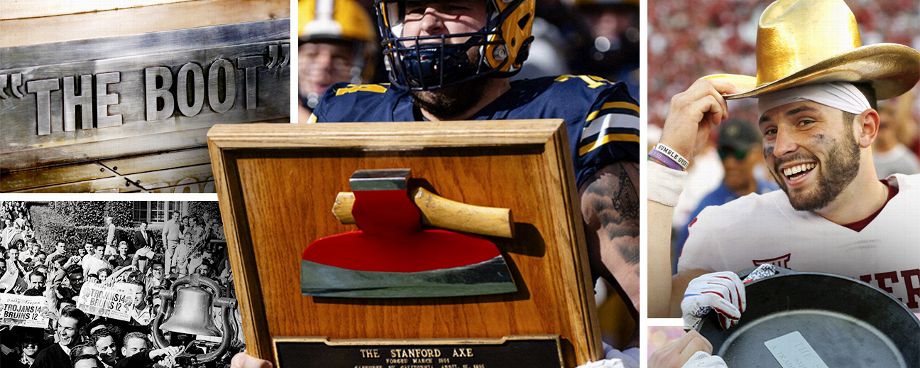
College football rivalries are steeped in tradition, with unique trophies symbolizing fierce competition and local pride. Each year, as the season reaches its climax, teams battle not only for victory but also for the honor of hoisting these distinctive trophies, which have become integral to the sport’s history. As Week 14 approaches, several high-stakes matchups will unfold, featuring iconic trophies that carry their own stories and significance.
Stanford Axe: A Legacy of Rivalry
The Stanford Axe is one of the oldest trophies in college football, originating from a 1899 incident when Stanford students acquired an axe to accompany their rallying cry. The axe was famously stolen by University of California students, leading to a dramatic chase. After a 31-year absence, it was returned to Stanford in 1930, and the two schools agreed to play for the axe starting in 1933. The trophy features an axe head mounted on a plaque, chronicling the outcomes of their encounters.
The rivalry dates back to March 19, 1892, and has seen both teams clash 128 times. Stanford leads the all-time record with 66 wins against California’s 51, including a record of 49-38-3 since the trophy’s introduction.
The Victory Bell’s Antics
Another notable trophy is the Victory Bell, contested between the University of Southern California (USC) and the University of California, Los Angeles (UCLA). Initially gifted to UCLA by the Alumni Association in 1939, the 295-pound bell has a checkered past, including a notorious theft by USC fraternity members in 1941. The rivalry intensified, leading both universities to make the bell the official trophy in 1942.
The all-time record favors USC, with 51 wins to UCLA’s 34. The teams will meet on Saturday, December 2, at 7:30 p.m. ET, heightening the stakes of their historic rivalry.
Michigan’s Paul Bunyan Trophy
The Paul Bunyan Trophy represents the fierce rivalry between the University of Michigan and Michigan State University. Commissioned in 1953, the trophy features a towering lumberjack figure standing on a representation of the state of Michigan. Despite its humble beginnings, the trophy has gained notoriety and is now celebrated as a symbol of pride for both teams.
The two schools first met in 1898, and Michigan leads the all-time series with 75 wins against Michigan State’s 38. Their next meeting is set for October 21.
The Territorial Cup: The Oldest Rivalry Trophy
The Territorial Cup is recognized as the oldest rivalry trophy in college football. First contested in 1899, the cup went missing for 83 years before being rediscovered in a church basement. In 2001, the schools solidified its status as the traveling trophy for their rivalry. Arizona leads the all-time series with 51 wins compared to Arizona State’s 46.
The two teams will face off on Friday, November 24, at 9 p.m. ET, as they vie for this historic accolade.
The Golden Boot and Other Unique Trophies
Among the more unusual trophies is the Golden Boot, awarded annually to the winner of the rivalry between LSU and Arkansas. Weighing nearly 200 pounds, this trophy symbolizes the geographic rivalry between the two states and has a value estimated at $10,000. The Golden Boot was first presented in 1996 and has become a hallmark of the annual matchup.
Another notable trophy is the Old Brass Spittoon, awarded since 1950 to the winner of the Indiana-Michigan State rivalry. This spittoon, purchased from an antique shop, has become a humorous yet cherished symbol of competition between the two schools.
The Commander-in-Chief’s Trophy: A Military Tradition
The Commander-in-Chief’s Trophy represents the annual competition among the U.S. service academies: Army, Navy, and Air Force. Established in 1972, this trophy is awarded to the academy with the best head-to-head record against the other two. The three-sided trophy features silver footballs atop a base adorned with the mascots of each academy.
The rivalry is a source of pride for the cadets, with the winner traditionally receiving an invitation to the White House, further adding to the trophy’s prestige.
As the college football season reaches its critical juncture, these trophies not only symbolize victories but also encapsulate the rich history and traditions that make college football a cherished pastime. With intense matchups ahead, teams are poised to battle for both glory and the opportunity to claim their respective trophies, adding another layer of excitement to the sport.







